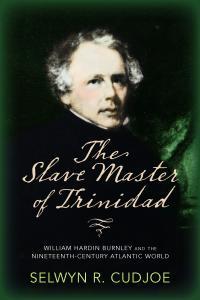Tithes & Thefts
By Dr Selwyn R. Cudjoe
January 8, 2020
PART 1
After it was reported that Pastor Vinworth Antony Dayal, leader of the Third Exodus Assembly Church, had assembled $29 million in assets over 19 years, Dr. Knolly Clarke, head of the IRO, declared: "Each church has their own way of doing things but in the Anglican Church and I think in the Roman Catholic, we have trustees. We audit our accounts every year. Our church is very strict with funds. It is not a one-man show" (Express, January 3, 2002).
This was not always the case. In June 1884 word rang out across the village that Archdeacon Henry Richards, prelate of St. Mary's Anglican Church in Tacarigua, was ailing. Richards lived in a spacious rectory on the Eastern Main Road that was built in 1841.
The Indians congregated around the rectory immediately. They were worried about the safety of the monies they had deposited with him. Afraid of banks, they buried their monies in their backyards or converted their savings into gold bangles that they wore upon their persons.
Between 1856 and 1883 many Indians and Africans had entrusted their life savings to Richards for safekeeping. During that period they deposited over $100,000 with him, his having offered them 5 percent interest on their deposits. This was a good deal since the local savings bank that was incorporated by Sir Ralph Woodford in 1824 offered only 3 percent interest on any amount less than £200. Indians were/are inveterate savers. Of the £100,279 pounds on deposit in the local savings banks in December 1887, £49,254 belonged to Indians.
A quick investigation determined that Richards had only $10,000 of the original deposits in the bank. Concerned about their money, more depositors went to the rectory to claim their money. They did not get a satisfactory answer from Richards. A few days later, Richards left Trinidad to visit friends in London. Two months later, he returned as mysteriously as he had left. Apparently, the governor ordered him to do so.
Indians from St. Vincent, Grenada, Carriacou, and the Gold Mines of Venezuela also deposited their savings with Richards. The interest was good; he was white; and a man of God. One newspaper reported: "Their confidence in him bordered on fanaticism. The slenderness of the tangible security on which sums, which in the aggregate must have amounted to hundreds of thousands of dollars, were deposited conclusively proves this."
His recording of their deposits was even more egregious. Depositors were given a receipt on a scrap of paper which was placed in an envelope and sealed by the Archdeacon. Subsequent payments or partial withdrawals were endorsed on the envelope with the seal of the envelope left unbroken. The depositor was enjoined not to break the seal. Failure to observe this injunction insured censure from Richards.
Richards' cunning raised his status in the eyes of the districkers. An Indian man had deposited two thousand dollars with Richards. A few months later, he returned to withdraw two hundred dollars to buy a piece of land. Richards said to him: "It's a pity that you have to break your deposit to buy a piece of land. I would lend you the money and you could pay me back as you continue to work."
Richards dipped into his office drawer and pulled out the money. The Indian man was gratified. His two thousand dollars would continue to generate 5 percent interest and he could pay back the Archbishop on a weekly basis. This simple act of generosity spread throughout the village like wildfire.
Money that was buried was unearthed and brought to Richards for safekeeping. An Indian woman and her six children, newly arrived from St. Vincent, heard of Richards' generosity. She sold all her bangles and put every cent into Richards' hands. When the bubble burst she went insane.
The local press called upon the government to act on behalf of the injured parties and quoted the relevant legislation ("The Fraudulent Bailee Ordinance) that held under the circumstances. They insisted the government had to bring Richards to judgment since he was an ecclesiastical officer and as such was under the government authority.
On September 13 Richards filed for bankruptcy. On September 26 a warrant was issued for his arrest. He immediately proceeded to the home of L. M. Fraser, Stipendiary Magistrate, in St. Joseph to whom he surrendered. John Cumming and J. R. Olton joined Richards at Fraser's home. Cumming provided the $1,000 security that was needed for Richards' release.
On October 9 Richards appeared for his hearings. One newspaper called it "one of the most disorderly scenes we have ever witnessed here." Over 300 Indians came to get their money. Several witnesses were examined before the case was adjourned. They were disappointed when Mr. Mc Hugh, the Indian interpreter, told them that the matter was adjourned. They became angry and threatening. They thought they were going to get back their money from Richards that day.
Richards engaged the services of the Hon. Charles Warner, the former attorney general, to represent him whereas the creditors retained George Garcia, another legal luminary. The Colonial Secretary called it "the most gigantic maladministration of fiduciary money ever perpetrated in the colony by an individual."
Richards' parishioners at St. Mary's raised over $300 to pay the retainer for his defense. One newspaper described this act as "touching proofs of the attachments and fidelity to their pastor in his present critical position. It cannot be long now before it is decided to what extent he is deserving of such blind confidence."
Next week I will tell of Archdeacon Richards' fate.
Professor Cudjoe can be reached @scudjoe@wellesley.edu. He can be reached @ProfessorCudjoe.
Share your views here...

The Slave Master of Trinidad by Dr. Selwyn R. Cudjoe
|

